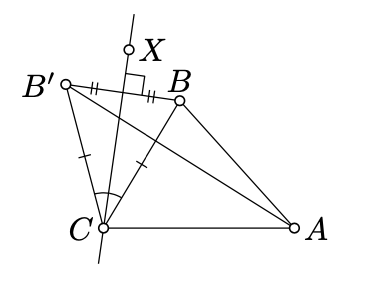11.3: Three angles of triangle
( \newcommand{\kernel}{\mathrm{null}\,}\)
Let △ABC and △A′B′C′ be two triangles in the neutral plane such that AC=A′C′ and BC=B′C′. Then
AB<A′B′ if and only if |∡ACB|<|∡A′C′B′|.
- Proof
-

Without loss of generality, we may assume that A=A′, C=C′, and ∡ACB, ∡ACB′≥0. In this case we need to show that
AB<AB′⇔∡ACB<∡ACB′.
Choose a point X so that
∡ACX=12⋅(∡ACB+∡ACB′).
Note that
- (CX) bisects ∠BCB′.
- (CX) is the perpendicular bisector of [BB′].
- A and B lie on the same side of (CX) if and only if
∡ACB<∡ACB′.
From Exercise 5.2.1, A and B lie on the same side of (CX) if and only if AB<AB′. Hence the result.
Let △ABC be a triangle in the neutral plane. Then
|∡ABC|+|∡BCA|+|∡CAB|≤π.
The following proof is due to Legendre [12], earler proofs were due to Saccheri [16] and Lambert [11].
- Proof
-
Set
a=BC, b=CA, c=AB,α=∡CAB, β=∡ABC, γ=∡BCA.
Without loss of generality, we may assume that α,β,γ≥0.

Fix a positive integer n. Consider the points A0,A1,...,An on the half-line [BA), such that BAi=i⋅c for each i. (In particular, A0=B and A1=A.) Let us construct the points C1,C2,...,Cn, so that ∡AiAi−1Ci=β and Ai−1Ci=a for each i.
By SAS, we have constructed n congruent triangles
△ABC=△A1A0C1≅△A2A1C2≅...≅△AnAn−1Cn.
Set d=C1C2 and δ=∡C2A1C1. Note that
α+β+δ=π.
By Proposition 11.2.1, we get that Δ≥0.
By construction
△A1C1C2≅△A2C2C3≅...≅△An−1Cn−1Cn.
In particular, CiCi+1=d for each i.
By repeated application of the triangle inequality, we get that
n⋅c=A0An≤≤A0C1+C1C2+⋯+Cn−1Cn+CnAn==a+(n−1)⋅d+b.
In particular,
c≤d+1n⋅(a+b−d).
Since n is arbitrary positive integer, the latter implies c≤d. By Proposition 11.3.1, it is equivalent to
γ≤δ.
From 11.3.1, the theorem follows.
Let ABCD be a quadrangle in the neutral plane. Suppose that the angles DAB and ABC are right. Show that AB≤CD.
- Hint
-
Set a=AB,b=BC,c=CD, and d=DA; we nned to show that c≥a.
Mimic the proof of Theorem 11.3.1 for the shown fence made from copies of quadrangle ABCD.


